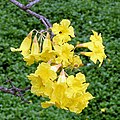Tabebuia aurea: Difference between revisions
m Replacing Image:Tabebuia_aurea.jpg with Image:Starr_040925-0010_Tabebuia_aurea.jpg (by Cecil because: Was in category "Duplicate", exact duplicate). |
m pt interwiki |
||
| Line 55: | Line 55: | ||
[[es:Tabebuia aurea]] |
[[es:Tabebuia aurea]] |
||
[[pt:Paratudo]] |
|||
Revision as of 00:42, 19 April 2009
| Tabebuia aurea | |
|---|---|

| |
| Scientific classification | |
| Kingdom: | |
| (unranked): | |
| (unranked): | |
| (unranked): | |
| Order: | |
| Family: | |
| Genus: | |
| Species: | T. aurea
|
| Binomial name | |
| Tabebuia aurea | |
| Synonyms | |
|
Handroanthus caraiba (Mart.) Mattos | |
Tabebuia aurea is a species of Tabebuia native to South America in Suriname, Brazil, eastern Bolivia, Peru, Paraguay, and northern Argentina, thus the common English name Caribbean Trumpet Tree is misleading. It is a small dry season-deciduous tree growing to 8 m tall. The leaves are palmately compound, with five or seven leaflets, each leaflet 6–18 cm long, green with silvery scales both above and below. The flowers are bright yellow, up to 6.5 cm diameter, produced several together in a loose panicle. The fruit is a slender 10 cm long capsule.[1][2]
It is a popular ornamental tree is subtropical and tropical regions, grown for its spectacular flower display on leafless shoots at the end of the dry season.[2]
This species is a crucial resource for Spix's Macaw (Cyanopsitta spixii), which is presently extinct in the wild with fewer than 100 birds remaining in captivity. Any future reintroduction would have to provide sufficient T. aurea for nesting and other purposes - while the tree is not considered threatened on a global scale, locally it has declined due to unsustainable use for timber.
References
- ^ Germplasm Resources Information Network: Tabebuia aurea
- ^ a b Huxley, A., ed. (1992). New RHS Dictionary of Gardening. Macmillan ISBN 0-333-47494-5.











